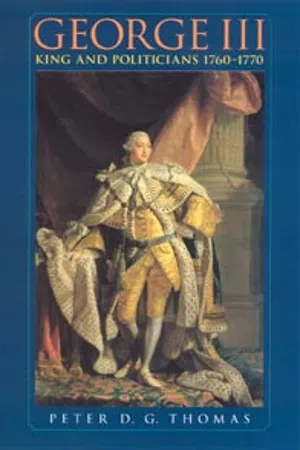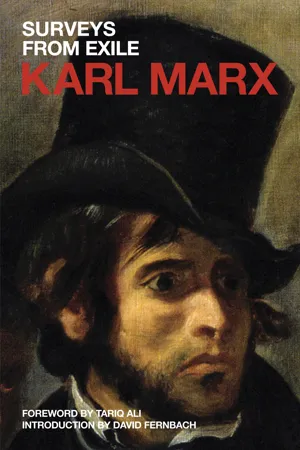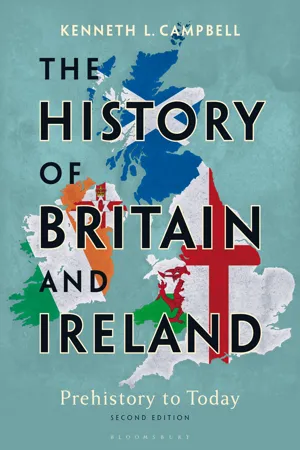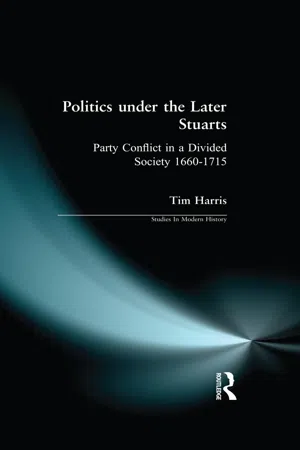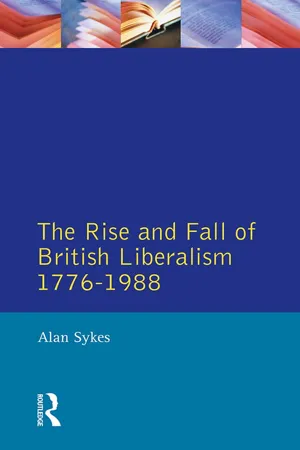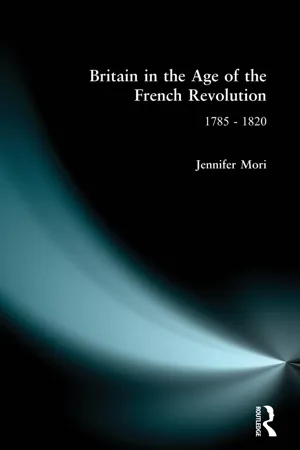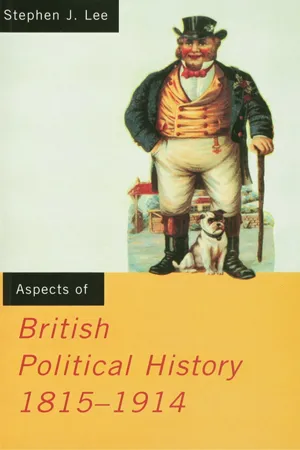History
Whig Party
The Whig Party was a political party in the United States that existed from the early 1830s to the mid-1850s. It was formed in opposition to the policies of President Andrew Jackson and the Democratic Party. The party advocated for a strong federal government, internal improvements, and a national bank. The Whig Party eventually dissolved due to internal divisions over the issue of slavery.
Written by Perlego with AI-assistance
Related key terms
Related key terms
1 of 4
Related key terms
1 of 3
10 Key excerpts on "Whig Party"
- eBook - ePub
George III
King and politicians 1760–1770
- Peter Thomas(Author)
- 2013(Publication Date)
- Manchester University Press(Publisher)
2 The political scenario in 1760Party terminology in eighteenth-century Britain is a minefield of myth, prejudice, and contradiction. Not since the 1720s had the line between administration and opposition been one between Whig and Tory parties. Outside the main Whig government party, headed since 1754 by the Duke of Newcastle, there existed smaller Whig factions, varyingly in and out of office. In the 1750s only two were of real significance. One was a small talented family group in which the leading figures were the foremost Commons orator William Pitt and his two Grenville brothers-in-law, George and the wealthy Lord Temple. This group went into opposition in 1755. The other, in opposition since 1751, was the clique of peers headed by the Duke of Bedford.Whigs in opposition naturally allied for tactical reasons with the dwindling rump of MPs, down to about 100 in the 1750s, whom many called Tory, because of their political ancestry and attitude of unvarying opposition. That pejorative designation was especially fixed on them by Whig ministers, to ensure that George I and George II excluded them from office, and there was some historical justification. Their championship of the privileged position of the Church of England, and resentment at Britain’s involvement in Europe, both had roots in Tory attitudes before 1714. But the seventeenth-century Tory party had also supported the Stuart monarchy, and Whig propaganda therefore sought to affix to Tories the stigmata of support of absolutism and also of Jacobitism, that movement to restore the exiled Stuarts to the throne. Hence developed the myth that the Glorious Revolution of 1688 had been solely a Whig achievement, a claim unfair to Tories past and present. In 1770 ‘Sir William Bagot, a country gentleman of ancient family … gave the most plausible and pleasing picture of a Tory that you can imagine’, wrote Parliamentary diarist James Harris. ‘He called them lovers of the Episcopal Church, but friends to toleration and the principles of the Revolution.’1 - eBook - ePub
- Eric J. Evans(Author)
- 2006(Publication Date)
- Routledge(Publisher)
The 1784 election offers a neat paradox. It showed clearly enough that the rights of the monarch in the political system could both be asserted and sustained. Pitt, the king’s choice, had been triumphantly endorsed by the electorate. Yet the king’s battles with his political opponents had caused those opponents to refine and develop the notion of party against which George III had ranged himself. Fox’s supporters now began to challenge the royal prerogative with organization, propaganda and a clear platform. Their tactics anticipated later party developments. It may even be, as Professor Cannon has suggested, that the king needed to fight fire with fire by marshalling his own anti-Foxite forces on party lines. Court politicians organized supporters, made arrangements for like-minded MPs to vote together and used propaganda to influence the electorate. An anti-party monarch had to organize a party to defeat his opponents. In the long term, as we shall see, party would expand to fill the vacuum in political life left as royal influence began to decline from the end of the eighteenth century. The king’s victory in 1783–4 had many pyrrhic elements.Party in 1783 was already over a century old. The terms Whig and Tory came into use in the later 1670s to describe the views of those respectively for and against the exclusion of Charles II’s Catholic brother, James, Duke of York (later James II), from legitimate succession to the throne. On the Whig side, party stressed the institution of parliament as a necessary brake on royal power; on the Tory side, it implied a defence of established institutions and, in particular, those of the monarchy. A pro-Whig writer concluded in the 1770s that the ‘most material doctrine’ of the early Tories was ‘to exalt the Crown to the possession of all those prerogatives at which Charles the First aimed’, while the Whigs sought ‘to limit the power of the Crown as much as possible, until prerogative was so much reduced, that the nation should be in fact tho not in form a Republick. The Tories were above all other things fast friends to the House of Stewart: the Whigs fast friends to Liberty alone.’ Such a view cannot be accepted without qualification, of course, but it is a reasonable statement of differing attitudes to royal power.Party battles were very fierce during the reign of Queen Anne (1702–14). Then other aspects of party, which would resurface as important distinguishing features as modern parties developed a century later, came to the fore. Tories were staunch, even fierce, defenders of the Church of England; they opposed the granting of religious toleration to nonconformist dissenters. Whigs supported toleration and, not surprisingly, attracted many dissenters from the expanding middle ranks of society. Throughout the reign, war with France raged. This war, the most costly Britain had yet fought, had to be paid for by taxation and by raising loans for the government. These loans paid useful rates of interest and merchants, traders and contractors benefited substantially from lending money. Those with most money to lend tended to be Whigs and Whigs supported the war. By contrast, smaller landowners increasingly opposed it. English country gentlemen were burdened by a land tax of 20 per cent (four shillings in the pound) levied to help pay for the war. The English counties became increasingly Tory in political sympathy. The land tax hit smaller landowners more heavily than it did commercial men. - eBook - ePub
Surveys from Exile
Political Writings
- Karl Marx(Author)
- 2020(Publication Date)
- Verso(Publisher)
14 that it is indeed a certain number of ‘liberal, moral and enlightened principles’ which constitutes the Whig Party, but that it was greatly to be regretted that during the more than a century and a half that the Whigs have existed, they have been, when in office, always prevented from carrying out these principles. So that in reality, according to the confession of their own historian, the Whigs represent something quite different from their professed ‘liberal and enlightened principles’. Thus they are in the same position as the drunkard brought up before the Lord Mayor who declared that he represented the temperance principle but from some accident or other always got drunk on Sundays.But never mind their principles; we can better make out what they are in historical fact; what they carry out, not what they once believed, and what they now want other people to believe with respect to their character.The Whigs, as well as the Tories, form a fraction of the large landed proprietors of Great Britain. Nay, the oldest, richest and most arrogant portion of English landed property is the very nucleus of the Whig Party.What, then, distinguishes them from the Tories? The Whigs are the aristocratic representatives of the bourgeoisie, of the industrial and commercial middle class. Under the condition that the bourgeoisie should abandon to them, to an oligarchy of aristocratic families, the monopoly of government and the exclusive possession of office, they make to the middle class, and assist it in conquering, all those concessions which in the course of social and political development have shown themselves to have become unavoidable and undelayable. Neither more nor less. And as often as such an unavoidable measure has been passed, they declare loudly that herewith the end of historical progress has been obtained; that the whole social movement has carried its ultimate purpose, and then they ‘cling to finality’.15 - Dick Leonard(Author)
- 2020(Publication Date)
- Routledge(Publisher)
The Parliament to which Pitt was elected was divided as much by faction as by party. The historical division between Whigs and Tories had become somewhat blurred during the 20 years that George III had occupied the throne. The long domination of the Whigs throughout the reigns of the first two Georges, which had seen the Tories steadily decline in both numbers and influence, was a thing of the past. The Whigs still saw themselves as the guarantors of the Glorious Revolution of 1688–89, believing in a limited monarchy, the supremacy of Parliament, a vigorous and basically anti-French foreign policy, free trade and relative religious tolerance. Led by an oligarchy of enlightened aristocrats, they tended to be arrogant, self-satisfied and to behave as though they were born to rule. The main Whig factions were led by three peers – the Marquess of Rockingham, the Earl of Shelburne and the Duke of Portland – with Charles James Fox the dominant figure in the House of Commons.The Tories, representing primarily the gentry, were strong supporters of the royal prerogative and the Church of England, tending to believe in the divine right of monarchs, and were long tainted by suspicions of Jacobitism, though this was less of a factor after the failure of the 1745 uprising of Bonnie Prince Charlie. They were also protectionist, and more isolationist in international affairs, putting their trust in the British navy to keep the nation out of danger. Their long eviction from power was ended by the accession of George III, who distrusted the Whig oligarchs and was determined to assert his own personal role. In 1762, he installed a Tory, the Earl of Bute, a personal favourite, as Prime Minister, but his ministry lasted for less than a year. There followed four short-lived Whig governments, one of them led by the Elder Pitt as Earl of Chatham, but in 1770, George succeeded in imposing a second Tory administration. This was led by Lord North MP, a much more substantial politician than Bute, who was to continue in office for 12 years. When Pitt was elected, his long rule was nearing its end, and he was largely discredited by the disasters of the American War of Independence.- eBook - ePub
The History of Britain and Ireland
Prehistory to Today
- Kenneth L. Campbell(Author)
- 2023(Publication Date)
- Bloomsbury Academic(Publisher)
10 Reform, War, and RebellionPolitical Culture in Britain and Ireland, 1746–89Threats to the Whig Oligarchy
At the midway point of the eighteenth century, the Hanoverians’ final victory over the Jacobites at Culloden Moor promised a continuation of politics as usual in the British Isles. However, before long several challenges to the Whig oligarchy threatened to upset the political stability that had seemed the hallmark of post-1688 Britain. Beneath the surface of the consensus that seemed to hold sway during the Walpole-dominated decades of the 1730s and 1740s, rifts had begun to occur within the Whig Party, primarily over foreign policy that presaged potential trouble ahead. Eighteenth-century politicians still lived in the shadow of the political turbulence that had marked seventeenth-century England, determined to maintain the precarious settlement established in 1688. It was only a matter of time though before issues would arise not easily smoothed over in an effort to cling to the past. By the beginning of the reign of George III in 1760, the Whig Party had divided into three identifiable groups. The radical Whigs favored parliamentary reform and opposed foreign expansion, while the imperialistic and politically conservative Whigs bore a remarkable resemblance to the Tories in their support of an imperialistic agenda and hostility toward reform. Moderate Whigs, such as Lord Rockingham, sought to mediate between them to preserve political stability and keep the party in power.1 The press would exacerbate these divisions by challenging the aristocratic monopoly on power, beginning with its coverage of the Wilkes controversy.In 1754, a 27-year-old John Wilkes failed in his first attempt to gain election to Parliament as MP for Berwick-upon-Tweed. In 1757, he managed to get himself elected as MP for Aylesbury, but he did so largely through bribery and ended up in deep financial difficulty. His debt could have derailed and discredited Wilkes but began to attract the attention and patronage of prominent men within the Whig Party, including the Secretary of State, William Pitt. In 1760, an opportunity presented itself for Wilkes to play a leading role in response to the first major threat to the Whig oligarchy and the political unity of the British ruling class. In that year, King George II died and his son, George III, succeeded him at the age of twenty-two. Determined to take a more active role in politics than his father had, George III relied heavily on his tutor, Lord Bute, in his efforts to avoid unwanted pressure from Parliament. Wilkes recognized that Whig politicians resented the undue influence Bute had over the king and the power Bute had gained because of that influence. Wilkes now had an issue he could use to his advantage. - eBook - ePub
Politics under the Later Stuarts
Party Conflict in a Divided Society 1660-1715
- Tim Harris(Author)
- 2014(Publication Date)
- Routledge(Publisher)
Court, Country and the Origins of PartyPrecisely when we can begin to talk about the emergence of party politics in England is a difficult question. Although the terms Whig and Tory did not come in to common usage until the Exclusion Crisis, the issues which divided the two groups did not suddenly burst onto the scene with Titus Oates’ revelations of a Popish Plot in the late summer of 1678: there had been growing fears about ‘popery’ and ‘arbitrary government’ throughout the 1660s and 1670s; the idea of excluding the Duke of York from the succession because of his Catholicism had been raised as early as 1674; and during this period we see increasing polarisation along political and religious lines both in Parliament and in society at large. From the late 1660s contemporaries were beginning to talk in terms of a clash between the Court (the supporters of a strong, royal executive) and Country (the champions of Parliament), and by the early 1670s most people were prepared to acknowledge the existence of Court and Country ‘parties’. Writing in 1682, Edmund Bohun asserted that the Commons during the last session of the Cavalier Parliament ‘were divided into two great Parties … the Court-Party and the Country-Party’;1 indeed, in 1677–8 the future Whig leader, the Earl of Shaftesbury, had been able to divide both Houses of Parliament fairly evenly between those who were ‘vile’ (supporters of the Court) and those who were ‘worthy’ (supporters of the Country).2To what extent, then, did the Court–Country groupings that had emerged by the mid-1670s anticipate the later partisan strife between Tories and Whigs? Most historians see a constitutional struggle between Court and Country, or between the royal executive and Parliament, as the dominant theme in politics in Charles II’s reign, pro viding a basic continuity between the pre-Popish Plot era and the Exclusion Crisis. J. H. Plumb, for example, has written that during this time ‘greater control of Parliament by the executive or greater independence from it became the crux of politics’, whilst Weston and Greenberg see the main conflict in politics as being between those who believed the King was the only supreme governor within the realm, and those who thought he shared his sovereignty with Parliament.3 Nowadays scholars tend to be sceptical as to whether we can talk about ‘parties’ before 1679: not only were the Court and Country factions not as coherent and well-organised as we once thought, but also politics at this time, so J. R. Jones maintains, ‘were largely contained within the restricted arenas of Whitehall and Westminster’, allowing little potential for the mobilisation of nationwide support on behalf of common and publicly stated objectives. Jones has also asserted that it would be wrong to see the Tory party as an outgrowth of the Court interest which the Earl of Danby had sought to construct in the mid-1670s: ‘Toryism, when it developed as a reaction to the introduction of Exclusion in May 1679, represented a fresh start.’4 Most would agree, however, that the first Whigs were the ideological heirs of the Country opposition of the mid-1670s; indeed, many of the leading Country spokesmen of the mid-1670s, who came to articulate the case against royal absolutism, were to be prominent members of the first Whig movement.5 - eBook - ePub
- Alan Sykes(Author)
- 2014(Publication Date)
- Routledge(Publisher)
Almost from the first, the Whigs relied upon the Conservatives for support against Radicals. In 1833 Conservative votes were required to defeat a Radical motion for triennial parliaments, and in 1834 to defeat a proposal to reduce pensions. Conservative support was also required to reverse the malt tax vote on the 1833 budget. As the government’s majority declined, so reliance on Conservative support became more frequent, especially in the difficult years after 1837, when the Whigs decided that association with Radicalism was an electoral liability and a succession of Radical proposals was defeated with Conservative assistance. 23 The Whig ideal of rule from above by a disinterested but wise and dutiful aristocracy, legislating only after independent deliberation, inhibited both party spirit and the development of party. In contrast to the Conservatives, who whipped strongly against the reform bill in 1831 and developed a high degree of cohesion under Peel’s autocratic leadership, Althorp, as leader of the House of Commons, was opposed to whipping on principle. 24 The Whig view of party, summed up by H.D. Goring, Whig MP for Shoreham, as ‘those Gentlemen I generally find myself able to support’, 25 was informal, the cooperation of like-minded men, but men who, in the words of Lord Brougham, lord chancellor in the Whig ministry of 1830–4, ‘want and ought to think for themselves’. 26 The Whigs were also reluctant to foster extra-parliamentary organisation because of their fears of Radical activism, and their awareness that the organisers and the press were markedly more Radical than the leadership. 27 The Reform Association, set up in 1835 to register the Whig-Liberal vote, was not ineffective in that role. The increase in registrations of Conservative voters during the 1830s reflected the shift of opinion towards Conservatism rather than any marked superiority in Conservative organisation - eBook - ePub
Britain in the Age of the French Revolution
1785 - 1820
- Jennifer Mori(Author)
- 2014(Publication Date)
- Routledge(Publisher)
CHAPTER ONE Parties and PoliticsOnce upon a time, the political history of Britain during the French Revolutionary wars was simple and straightforward. Parliament, for much of the eighteenth century an assembly of independent MPs whose voting preferences were determined primarily by factional and family connections, reacted to the French Revolution by dividing into two groups. William Pitt the Younger, despite a liberal youth, had seemingly taken fright when confronted by the emergence of a militant French Revolution in Europe and democratic parliamentary reform at home. Having taken Britain to war against revolutionary France in 1793, supported by a corps of ministerial MPs who shared his fears, Pitt would superintend the emergence of a new Tory Party committed to the defence of the status quo ante helium in Britain and Europe. A gallant band of liberal Opposition Whigs led by Charles James Fox, in sharp contrast, defended the civil liberties of Britons against the repressive policies of a reactionary government, finally coming to power in 1830 as a pro to-Liberal Party.Like all sharply delineated dichotomies, the division of British politicians into Whigs and Tories obscures the complexities of political theory and practice during the French wars. Although the French Revolution began to divide British high politics into groups that would become the Liberal and Conservative Parties of the nineteenth century, this bipolar split was superimposed over an older Commons comprised of Court, Country and independents that continued to exist up to 1832 (O'Gorman, 1982: 116-21). Pitt and Fox, the two great antagonists of the French wars, were canonised by the Victorians as the founding fathers of the Liberal and Conservative Parties, but these were apotheoses that ignored the many inconsistencies in the thoughts and actions of both men, not to mention the conduct of their contemporary and posthumous admirers. The aristocratic Whiggism of the Foxites made them ambivalent about the wisdom of franchise and electoral reform, so much so that no party line could be laid down on the issue after Fox's death (Mitchell, 1967: 15-17; O'Gorman, 1982: 39—40, 68, 101-2; Smith, 1992: 210-11). The unity of the Pittites had been shattered by the resignation of their leader in 1801 in defence of Catholic Emancipation and they divided thereafter into pro- and anti-emancipation camps for the next three decades (O'Gorman, 1982; Sack, 1987; Harvey, 1978a,b). The nineteenth-century two-party system would be built upon myths of supposed strong leadership and intellectual consistency. The reality was different and much more complex. - eBook - ePub
- Stephen J. Lee(Author)
- 2013(Publication Date)
- Routledge(Publisher)
5 J.R. Green, a near-contemporary of Macaulay, went a stage further by assuming that this capacity for progress was unique to the English-speaking peoples. It was a result of their predominantly beneficial historical experiences which had fostered toleration and liberty via landmarks like Magna Carta, the ‘Glorious Revolution’ of 1689, and the 1832 Reform Act. It was common to all ‘Whig’ historians to make value judgements, to see history as the triumph of progress over stagnation, of reform over reaction. Fundamental to this was the intervention of benevolent influences aiming consciously at reform; these, whether individuals or political parties, were driven as much by altruism as by self-interest.Against all this is the so-called ‘Tory’ reaction, a development which is exclusively of the twentieth century and which owes much to the meticulous and detailed research of Sir Lewis Namier. The ‘Tory’ method reverses the ‘Whig’ approach in two ways. First, it attaches much less importance to the influence and ideas of individuals, whether politicians or theorists, and sees changes or reforms occurring in a more impersonal manner. Second, ‘Tory’ history stresses the multiplicity of the influences on any one period or sequence of events. Causation therefore becomes more unpredictable and complex. This is partly because it depends upon more detailed research. According to Namier, ‘One has to steep oneself in the political life of a period before one can safely speak, or be sure of understanding its language’.6 The ‘Tory’ approach therefore produces an intricate patchwork of more detailed studies rather than the more easily identifiable line favoured by the ‘Whigs’. The ‘Tories’ emphasise depth of study, with the method seen as of equal importance to the deduction, while to the Whigs the deduction is the rationale and the revelation. ‘Tory’ history explains, ‘Whig’ history justifies.A third approach to historical study is the ‘Marxist’ interpretation. In their Communist Manifesto of 1848, Marx and Engels wrote that ‘The history of all hitherto existing society is the history of class struggles’.7 - eBook - ePub
- Richard Gaunt(Author)
- 2020(Publication Date)
- Routledge(Publisher)
Let the evidence of their own partisan, Mr. Nicholls, again be taken on this point:“The leading members of the Whig Party were at that time (1792), the Duke of Portland, Earl Fitzwilliam, and Earl Spencer. I believe that Earl Fitzwilliam and Earl Spencer were wholly free from any desire to obtain office or emoluments; but both of them had been educated from early life in that leading principle of the Whig Party, that they were to acquire power by a confederacy of great families. I date the origin of that party, which is now denominated the party of the great Whig families, from the fall of Sir Robert Walpole. Their principle was to possess influence by confederacy.”—Vol. i. p. 140.Such was the character and leading feature of the Whigs, as much as forty years ago, in the eyes of one of their own supporters. We grant, without hesitation, that they have been, within the last three years, driven by circumstances to throw themselves on the popular feeling; or rather, we should say, to do something which might engage the popular feeling and sympathies in their behalf. In this attempt they have succeeded in part: they have gained a large amount of temporary support; but it is only that kind of support which is accorded, like daily alms, to those in whom no real confidence is placed. Ten thousand electors supported the Whig candidates at the last general election, who would, in all probability, support their opponents at the next; and who yet, if charged with tergiversation, would sincerely and indignantly repel the charge, and declare that “they never were Whigs; nor ever pretended to be; however they might, from temporary motives, have sided with the Whigs on the former occasion.”But, to ascertain the reality of the fact of there being any Whig Party among the people of England, we ought not to judge by the present excited moment. Those only are really Whigs who are so from principle; and who were not ashamed of the name, when Toryism enjoyed power and ascendancy.
Index pages curate the most relevant extracts from our library of academic textbooks. They’ve been created using an in-house natural language model (NLM), each adding context and meaning to key research topics.
Explore more topic indexes
Explore more topic indexes
1 of 6
Explore more topic indexes
1 of 4
